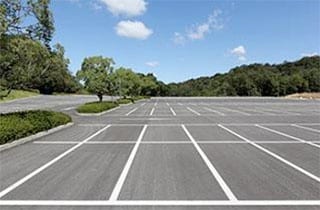5 Ways to Pave the Planet Green with Parking Lot & Road Maintenance
Worldwide, infrastructure is constantly expanding to support our growing population. Cities are constantly paving new roads and resurfacing old roads to accommodate increased vehicle traffic.
However, there are several long-term adverse environmental effects associated with road and parking lot paving. The time has come to mitigate these potential problems with sustainable solutions.
How Is Paving Affecting Sustainability?
Most roads are made from concrete or asphalt. Mining the raw materials for either product requires massive amounts of energy and disrupts the environment from which they are extracted.
Producing cement, an essential component of concrete, releases high levels of VOCs (volatile organic compounds) into the atmosphere. VOC emissions are harmful to the environment and contribute to ozone depletion.
Asphalt is a petroleum-based paving material. Drilling for oil also requires a significant amount of energy and the environmental hazards associated with extracting oil have been well documented.
Environmental impact does not end at the manufacturing stage. Paving new roads and parking lots disrupts the underlying soil and water table. Soil beneath the paved surface that would otherwise guide rainwater into underground streams and eventually into rivers and waterways immediately dries up. Rainwater instead is channeled into engineered drainage systems that direct the water into municipal sewage systems before dumping it into rivers and lakes.

Further, striping paints and sealers for roads and parking lots often utilize petroleum in their formulation and/or feature high-VOC emissions.Although producing materials and laying new pavement is wrought with environmental consequences, you can mitigate the impact of your next project. Here are five sustainable innovations to consider when paving your next road or parking lot:
5 Ways to Make Your Next Pavement Project Green
1. Recycle asphalt and concrete.
Roadways and parking lots can be produced from recycled asphalt and concrete. This process is far less resource-intensive than using virgin materials. Often, material from old roadways can be recycled on-site and included in the new surface.
2. Apply porous pavement.
To eliminate the water drainage problem promote natural water flows, porous asphalt and concrete produced from recycled material allows water to flow naturally into the soil beneath. Initially, porous pavement was met with skepticism regarding durability, but innovative engineering in recent years has addressed those concerns.
3. Use permeable pavers.
Permeable pavers are an energy-reducing solution when constructing a parking lot. Their pap spacing also allows natural drainage, creating a more sustainable parking lot surface. The technology increases flexibility for an aesthetically pleasing design.
4. Apply a bio-based asphalt sealant.
Whether used for parking lots, roads or driveways, low-VOC, PAH-free soy-based sealants are a highly useful—and environmentally friendly—way to repair and reseal paved surfaces.
5. Rely on soy-based striping paints.
BioStripe® road striping paints, made from soy oil rather than petroleum, provide a low-VOC option for striping parking lots, roads and bike paths. Along with being the only USDA Certified Biobased traffic paint, BioStripe® offers premium performance compared to traditional traffic safety paints.
How does your organization pave the planet green? Share your thoughts in the comments below.
Are you looking to resurface your driveway with an eco-friendly product? Learn more about the safer way to rejuvenate & seal your driveway, BioSealSafe™.


